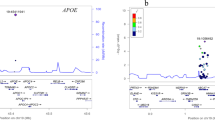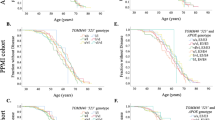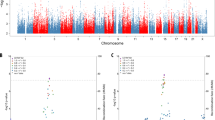Abstract
The gene coding for ubiquilin 1 (UBQLN1) is located near a linkage peak on chromosome 9q22.2 and it also impacts the function of presenilin proteins involved in early-onset Alzheimer's disease (AD). Recently, genetic variation in UBQLN1 has been shown to affect the risk of AD in two independent family-based samples. The purpose of this study was to confirm the reported association in a large case–control sample and to also examine the association of UBQLN1 SNPs with quantitative measures of AD progression, namely age-at-onset (AAO), disease duration and Mini-Mental State Examination (MMSE) score. We examined the associations of three SNPs in the UBQLN1 gene (intron 6/A>C, intron 8/T>C and intron 9/A>G) in up to 978 LOAD cases and 808 controls. All SNPs were in significant linkage disequilibrium (P<0.0001). While modest significant associations were observed in the single-site regression analysis, 3-site haplotype analysis revealed significant associations (P<0.0001 for overall haplotype analysis). One common haplotype (H4) defined by intron 6/A–intron 8/C–intron 9/G alleles was associated with AD risk and one less common haplotype (H5) defined by intron 6/C–intron 8/C–intron 9/A alleles was associated with protection. The adjusted odds ratios with potentially one and two copies of risk haplotype H4 were 1.5 (95% CI: 0.99–2.26; P=0.054) and 3.66 (95% CI: 1.43–9.39; P=0.007), respectively, and odds ratio for haplotype H5 carriers was 0.31 (95% CI: 0.10–0.95; P=0.0398). In addition to disease risk, the homozygosity of the risk haplotype was also associated with older AAO, longer disease duration and lower MMSE score. In summary, our data from a large case–control cohort indicate that genetic variation in the UBQLN1 gene has a modest effect on risk, AAO and disease duration of AD. Our haplotype data suggest the presence of additional putative functional variants either in the UBQLN1 gene or nearby genes and provide strong justification for additional work in this region on chromosome 9.
This is a preview of subscription content, access via your institution
Access options
Subscribe to this journal
Receive 12 print issues and online access
$259.00 per year
only $21.58 per issue
Buy this article
- Purchase on Springer Link
- Instant access to full article PDF
Prices may be subject to local taxes which are calculated during checkout

Similar content being viewed by others
References
Seshadri S, Drachman DA, Lippa CF . Apolipoprotein E epsilon 4 allele and the lifetime risk of Alzheimer's disease. What physicians know, and what they should know. Arch Neurol 1995; 52: 1074–1079.
Slooter AJ, Cruts M, Kalmijn S, Hofman A, Breteler MM, Van Broeckhoven C et al. Risk estimates of dementia by apolipoprotein E genotypes from a population-based incidence study: the Rotterdam Study. Arch Neurol 1998; 55: 964–968.
Kamboh MI . Molecular genetics of late-onset Alzheimer's disease. Ann Hum Genet 2004; 68: 381–404.
Pericak-Vance MA, Grubber J, Bailey LR, Hedges D, West S, Santoro L et al. Identification of novel genes in late-onset Alzheimer's disease. Exp Gerontol 2000; 35: 1343–1352.
Myers A, Wavrant De-Vrieze F, Holmans P, Hamshere M, Crook R, Compton D et al. Full genome screen for Alzheimer disease: stage II analysis. Am J Med Genet 2002; 114: 235–244.
Blacker D, Bertram L, Saunders AJ, Moscarillo TJ, Albert MS, Wiener H et al. Results of a high-resolution genome screen of 437 Alzheimer's disease families. Hum Mol Genet 2004; 12: 23–32.
Lee JH, Mayeux R, Mayo D, Mo J, Santana V, Williamson J et al. Fine mapping of 10q and 18q for familial Alzheimer's disease in Caribbean Hispanics. Mol Psychiatry 2004; 9: 1042–1051.
Bertram L, Hiltunen M, Parkinson M, Ingelsson M, Lange C, Ramasamy K et al. Family-based association between Alzheimer's disease and variants in UBQLN1. N Engl J Med 2005; 352: 884–894.
McKhann G, Drachman D, Folstein M, Katzman R, Price D, Stadlan EM . Clinical diagnosis of Alzheimer's disease: report of the NINCDS-ADRDA Work Group under the auspices of Department of Health and Human Services Task Force on Alzheimer's Disease. Neurology 1984; 34: 939–944.
Wang X, DeKosky ST, Luedecking-Zimmer E, Ganguli M, Kamboh IM . Genetic variation in alpha(1)-antichymotrypsin and its association with Alzheimer's disease. Hum Genet 2002; 110: 356–365.
Folstein MF, Folstein SE, McHugh PR . ‘Mini-mental state’. A practical method for grading the cognitive state of patients for the clinician. J Psychiatr Res 1975; 12: 189–198.
Lewontin R . The interaction of selection and linkage I: general considerations, hetorotic models. Genetics 1964; 49: 49–67.
Ihaka G . A language for data analysis and graphics. J Comp Graphic Stat 1996; 5: 299–314.
Massey LK, Mah AL, Monteiro MJ . Ubiquilin regulates presenilin endoproteolysis and modulates ϒ-secretase components, Pen-2 and nicastrin. Biochem J 2005; 391: 513–525.
Luedecking-Zimmer E, DeKosky ST, Nebes R, Kamboh MI . Association of the 3′ UTR transcription factor LBP-1c/CP2/LSF polymorphism with late-onset Alzheimer's disease. Am J Med Genet B Neuropsychiatr Genet 2003; 117B: 114–117.
Luedecking-Zimmer E, DeKosky ST, Chen Q, Barmada MM, Kamboh MI . Investigation of oxidized LDL-receptor 1 (OLR1) as the candidate gene for Alzheimer's disease on chromosome 12. Hum Genet 2002; 111: 443–451.
Daw EW, Payami H, Nemens EJ, Nochlin D, Bird TD, Schellenberg GD et al. The number of trait loci in late-onset Alzheimer's disease. Am J Hum Genet 2000; 66: 196–204.
Slifer MA, Martin ER, Haines JL, Pericak-Vance MA . The ubiquilin 1 gene and Alzheimer's disease. N Engl J Med 2005; 352: 2752–2753.
Bertram L, Tanzi RE . The ubiqilin gene and Alzheimer's disease. N Engl J Med 2005; 352: 2753.
Acknowledgements
This study was supported by National Institute on Aging grants AG 13672 and AG 05133. We thank Ms. Margaret Kenney for providing help in statistical analyses.
Author information
Authors and Affiliations
Corresponding author
Rights and permissions
About this article
Cite this article
Kamboh, M., Minster, R., Feingold, E. et al. Genetic association of ubiquilin with Alzheimer's disease and related quantitative measures. Mol Psychiatry 11, 273–279 (2006). https://doi.org/10.1038/sj.mp.4001775
Received:
Revised:
Accepted:
Published:
Issue Date:
DOI: https://doi.org/10.1038/sj.mp.4001775
Keywords
This article is cited by
-
Remodeling without destruction: non-proteolytic ubiquitin chains in neural function and brain disorders
Molecular Psychiatry (2021)
-
The ubiquilin gene family: evolutionary patterns and functional insights
BMC Evolutionary Biology (2014)
-
Effects of Ubiquilin 1 on the Unfolded Protein Response
Journal of Molecular Neuroscience (2009)
-
Transcriptomic and genetic studies identify IL-33 as a candidate gene for Alzheimer's disease
Molecular Psychiatry (2009)
-
Alzheimer’s disease: epidemiology, genetics, and beyond
Neuroscience Bulletin (2008)



